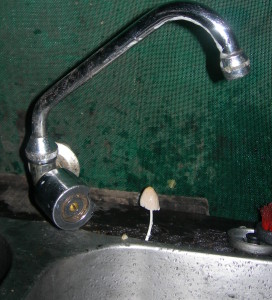As I mentioned in my last post, there are a number of issues facing fungi around the world. Researchers continue to look into how best to support fungi populations, but it seems like there are some patterns to effective fungi conservation– we need to know which fungi are present, we need to look at microhabitat conditions, and we need to be persistent in our efforts.

This mushroom in our field kitchen was around for 3 days- if we hadn’t been there at the right time, I wouldn’t have found it.
Starting with the basics, we have to know which species are present in a location and in what abundances before we can do anything about conservation. And this is no easy task- fungi are easiest to detect when they produce the fruiting bodies we see as mushrooms, but those are only visible for a short period of time, so it’s very difficult to document all present species at the same time (Molina 2008). Plus different fungi can look very similar, so we need to add information from genetic analysis to be sure we’ve identified everything (Hibbett and Glotzer 2011). Luckily there a large number of non-scientists who are interested in fungi, and their knowledge of what is growing where can be incredibly helpful to researchers trying to document important fungi (Buchanan and May 2003).
Protecting habitat is also a bit complicated. We know that fungi like moist locations, and the availability of dead plant material is also important for a lot of species (Bässler et al. 2010), but those conditions can be a challenge to protect over large scales because fungi are more responsive to conditions immediately surrounding them, in other words the microclimate, than they are to larger climate and terrain characteristics. A study from India found that more fungi sporocarps were found in sacred groves, which had more canopy cover and dead wood than forest reserves and coffee plantations, but these species were different from the ones found in the other two habitats (Brown et al. 2006)- they suggested the best way to protect threatened fungi was to conserve a network of different habitat types. Lonsdale et al. (2007) also suggested managing available dead wood to ensure what they called “dead wood flow”- the dead wood needs to be present as a substrate for fungal growth, but it also needs to form a spatial network that will allow fungi species to disperse from one location to another; if habitat for spores is separated by great distances, we could end up with isolated populations that are very vulnerable to local changes.
And one of the most important tasks is to make fungi conservation something that is a regular part of the discussion. Minter (2011) suggested that the way we tend to speak about biodiversity is part of the issue- “flora and fauna” doesn’t make a case for fungi. It’s also true that conversations about conservation planning don’t automatically include consideration of fungi- researchers working with fungi conservation in the Pacific Northwest found it necessary to keep reminding decision-makers that fungi were included in conservation efforts (Molina 2008).
Fungi conservation is an important part of ecosystem conservation, but we’re still learning how best to go about it. And the lack of attention to fungi in general tends to make efforts more complicated, but we are getting more information all of the time. There’s also a lot of promise for collaboration between amateur and professional fungi enthusiasts. Even if we don’t know a great deal about fungi, there are probably things we can all do to help fungi conservation- for my final post of the month, I’ll see what I can find in terms of public involvement.
Works cited:
Bässler C, Müller J, Dziock F, Brandl R. 2010. Effects of resource availability and climate on the diversity of wood-decaying fungi. J. Ecol. 98:822–832.
Brown N, Bhagwat S, Watkinson S. 2006. Macrofungal diversity in fragmented and disturbed forests of the Western Ghats of India. J. Appl. Ecol. 43:11–17.
Buchanan PK, May TW. 2003. Conservation of New Zealand and Australian fungi. N. Z. J. Bot. 41:407–421.
Hibbett D, Glotzer D. 2011. Where are all the undocumented fungal species? A study of Mortierella demonstrates the need for sequence-based classification. New Phytol. 191:592–596.
Lonsdale D, Pautasso M, Holdenrieder O. 2007. Wood-decaying fungi in the forest: conservation needs and management options. Eur. J. For. Res. 127:1–22.
Minter D. 2011. Fungal conservation needs help from botanists. Plant Biosyst. – Int. J. Deal. Asp. Plant Biol. 145:945–949.
Molina R. 2008. Protecting rare, little known, old-growth forest-associated fungi in the Pacific Northwest USA: a cast study in fungal conservation. Mycol. Res. 112:613–638.
